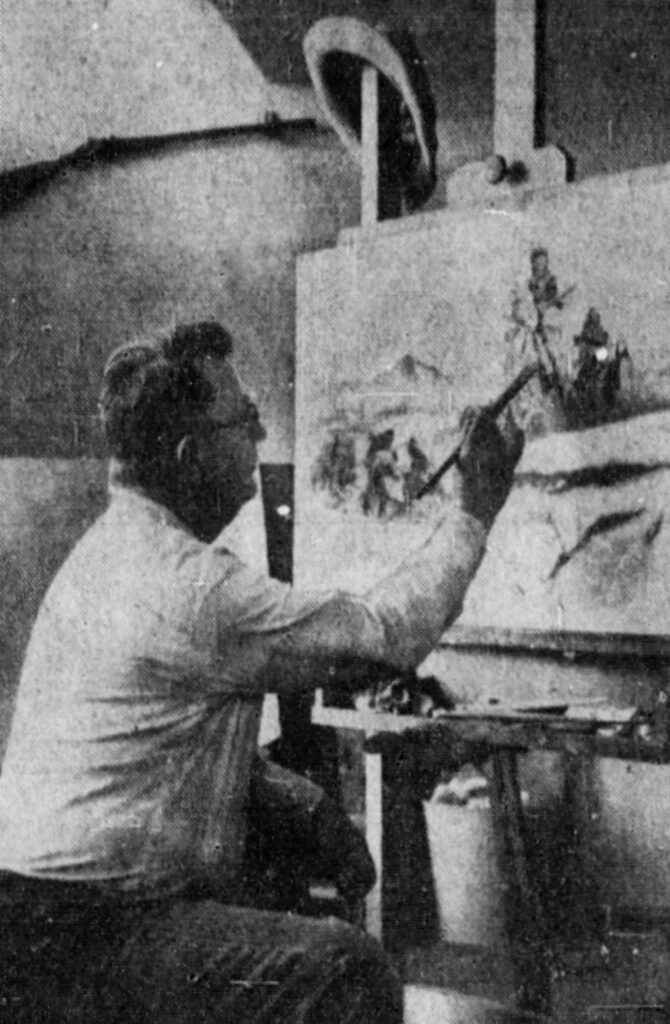Charlie Dye, famous illustrator and cowboy artist, on how he got into illustration and what he found it to be.

“My career in Art has been typical of so many others, that only in detail does it differ. I first studied in Chicago and started in advertising art there in the Windy City. Then I moved to New York City and studied with Harvey Dunn, the famous illustrator, and got into the publishing field. There have been headaches and triumphs, but all in all, a whale of a lot of fun.
“I was born in Canyon City. Colorado in 1906. My father was one of the Texas Trail cattle drovers who fell in love with the big mountains. My mother was raised on the edge of Indian Territory in Kansas. I don’t remember when I first rode a horse or threw my first rope; that was the beginning of my life and I loved it. I sketched that life a little, but had no idea that I might become an artist.
“If a big black horse had not put me in the hospital for long enough to do some thinking, I might still be some sort of a cowman. While recovering, I discovered the pen drawings of Charlie Russell. That did the trick, and whet my appetite to want to study art. so off to Chicago and the American Academy of Art.”
“I landed there with a straw suitcase and still wearing my boots. I was nearly as big a shock to Chicago as it was to me. and it took all my willpower to stick with it at first. I doubt very much that my artistic I.Q. was very high, but I happened to study with a grand bunch of students and instructors.
“My first art job had to do with designing egg cartons. It is a long jump from that to doing covers for national magazines. Before I left Chicago for New York City. I had become one of the many young “figure artists” who worked for the various top art studios.”
“I never knew Frank (Hoffman) very well — who did? I was an apprentice up at Flowing’s when he was a star up there, along with Davis, Felix Schmidt and other big shots of the old days. I wouldn’t say that Frank was the kind of guy to have a fatherly interest in apprentice illustrators. In fact, all of us kids were scared to death of him.
“Once I had to do something that if he had found it out, he would have skinned me alive. There was a young art director (who shall remain nameless, as he is a real big shot now). I forget the agency he was with, there in Chicago, but all the illustrators had trouble with doing a drawing for him. He was the kind of guy that felt a drawing just had to have a change before it was any good, or perhaps he was trying to build himself up in the agency. Frank did a dry-brush drawing for him showing a stagecoach being chased by Indians. Full spread newspaper ad for a bank. It was a dandy Hoffman — loose, dramatic and chuck full of action. Anyhow, this director sent it back as he had found fault with one of the horses.”
Charlie continued with his story. “I was stretching a canvas for Hoffman when Flowing brought the drawing back. Frank was so damn mad he made the old Mather Tower shake . . . chased both Bill Flowing and me out of his studio. Later that afternoon I went back in and finished stretching the canvas. Frank didn’t say a word. He was reading a manuscript from the Post. I went back to the bull-pen after finishing the canvas and Bill Flowing asked me if Frank had made the change. It was due at the engravers by five and the art director had been calling to see if it was ready.
“Finally this art director got really worried and came over to the studio and barged right into Frank’s studio. He said, “Frank, where is my drawing?” Frank beckoned him to the window. “Do you see those little white specks down there in the parking lot? Well, there is your _ drawing. No two-bit punk like you can tell me how to draw a horse!” Then Frank slammed out of the place and went home.
“Bill Flowing sent me down to the parking lot to get the pieces. I had to strip them and re-mount them, remove the tire marks with white tempera, and patch the drawing up the best I could. It ran next day without any changes by Hoffman . . . only by Dye. Frank was sore as a bear when he saw it in the paper, but Bill Flowing wouldn’t tell him who fixed it up. I had that proof for a long time until it just fell apart from age. The funny part of this story is that Frank Hoffman did a lot of work for this same guy afterward.”
And that’s what makes him a professional, isn’t it?
(This article is an excerpt from an article in Southwestern Art, Spring 1977).
This essay reminds me that I have an original cover painting for Adventure, February 1951 signed by Dye. The Fictionmags Index incorrectly credits Rafael DeSoto as the cover artist.